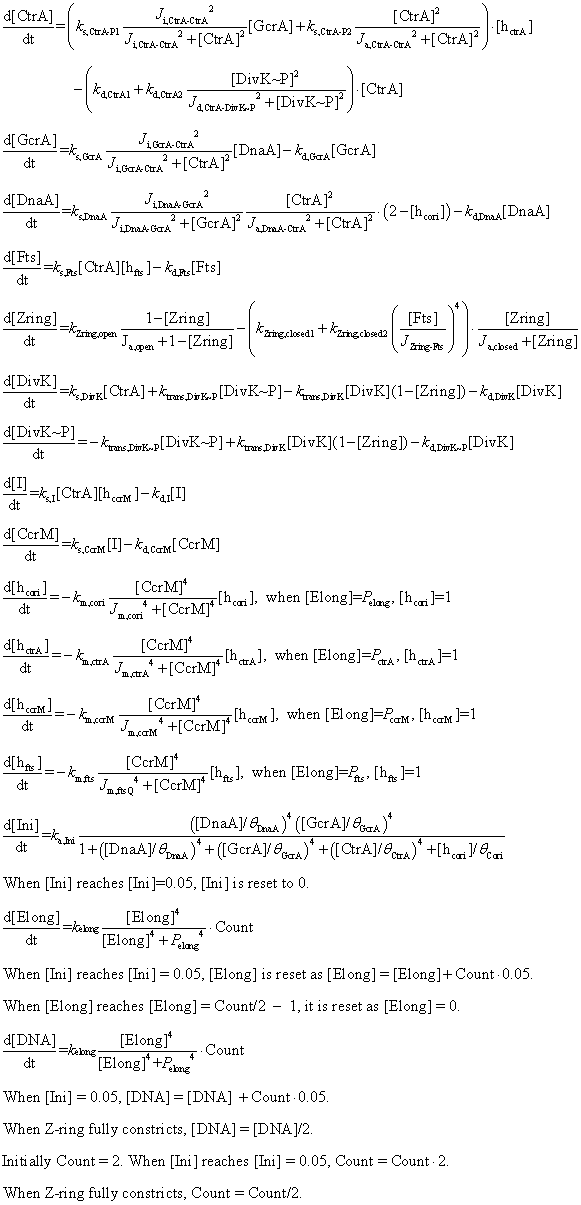Equations of the model

Symbols:
k = rate constants (min-1), J = binding constants (dimensionless), θ = thresholds (dimensionless), P = position of genes relative to origin site (dimensionless). s = synthesis, d = degradation, a = activation, i = inactivation, trans = transformation (phosphorylation and dephosphorylation in our case).
Variables:
- [I] = activity of an intermediate component or pathway that introduces a time delay between CtrA activation of ccrM transcription and the accumulation of CcrM protein.
- [Fts] = a lumped representation of Fts series proteins as required for Z-ring constriction.
- [Zring] = state of the Z-ring; for fully open [Zring] = 1 and for fully constricted [Zring] = 0.
- [Ini] and [Elong] represent the initiation of DNA replication forks and the progression of forks along the DNA molecule, respectively.
- [DNA] = the total amount of DNA in the cell, scaled to the amount of a full chromosome. The total DNA starts to increase when initiation finishes and is updated with same speed as the elongation [Elong] grows. Both the elongation and the total amount of DNA increase with possible multiple chromosome replication in specific mutants.
- Count = a number of chromosomes in the cell. Count is used here in case the multiple initiation happens from several chromosomes when cell does not divide (initiation then is assumed to happen simultaneously on all chromosomes). When initiation is successfully accomplished, 'Count' is doubled.
- [hcori], [hccrM], [hctrA] and [hfts] represent probabilities of hemimethylated states of Cori & dnaA, ccrM, ctrA and fts genes, respectively, during the cell division cycle.
- All other variables represent scaled protein concentrations.
Notes on equations:
- (1) The rates of protein expression from ctrA promoter can be written as a product of the probability of transcription factors to be bound and the probability that the locus is hemimethylated. The same assumption is also adopted for dnaA, fts, and ccrM expression. Specifically, dnaA expression is assumed to be half-decreased when the gene is hemimethylated reflecting the experimental facts that dnaA has a peak expression only during the swarmer-to-stalked cell transition and that corresponding protein level during the stalked cell cycle is almost constant (Zweiger and Shapiro, 1994). Furthermore, as dnaA is very close to Cori, and in order to avoid introducing an extra variable [hdnaA], we use (2 - [hcori]) term to describe the methylation effect on DnaA production rate.
- (2) The rates of [hcori], [hccrM], [hctrA] and [hfts] are designed to switch on abruptly when the DNA replication fork passes the gene¡¯s position on the chromosome. They switch off as the new DNA strand is methylated by a high concentration of CcrM.
- (3) Initiation of DNA synthesis is designed to occur when DnaA and GcrA are sufficiently abundant, CtrA concentration is low, and Cori is fully methylated. Protein binding to the origin site is assumed to be cooperative (nH = 4). Hemimethylation, on the other hand, is more likely to inhibit re-licensing in a non-cooperative manner. The rate of DNA elongation is nearly constant after initiation, until the forks reach the termination site, when [Elong] = 1. The total amount of newly synthesized DNA and the number of chromosomes per cell are calculated based on initiation events, DNA elongation, and Z-ring constriction.
 webmaster
webmaster